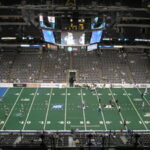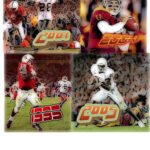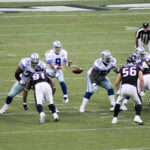First off, a bit by way of introduction: Ultimate Frisbee is a seven-on-seven sport played on a field about the size of an NFL football field. The disc is worked up the field by passes between teammates, and a point is scored when the disc is caught in the opponents’ end zone. The catch? You can’t run with the disc is your hands, and once you catch it, someone is going to be marking you up, cutting off half of the field and pressuring you to throw it away. So not only does each player have to be both a twinkle-toeing receiver and an eagle-eyed quarterback, but they also have to be fleet-footed defenseman. Because once the disc is dropped or intercepted it is a turnover, and the other team can start marching right back up the field.
Now, onto the main course. I have a buddy who is a handler on a pretty decent college team. He is a real student of the game, and he has prided himself over recent years on learning exactly how to run an effective offense. All his reading and teaching has taught him that once the disc is tapped in, the person in the back of the stack should charge into the open lane. At three seconds a cut, you should be able to reliably get off three good cuts, two to the open side and one to the break side, and a decent handler should be able to find an opening in there. Then, of course, you go to the dump-swing-score drill that you’ve practiced so much, surgically carving little bits of yardage up the field without ever risking a turnover.
Sure, it’s nice to have a game plan so you don’t have to figure something out on the spot all the time, but there is a problem with this strategy: every other experienced player on the field sees it coming a mile away! It is a lot easier to defend someone when you know exactly where he is going to cut. If you are the last defender back, you don’t have to worry about helping someone who is beat deep, and you can poach the open lane to cut off that first cut. This leaves the defender at the front of the stack, who would usually be poaching the open lane, to shift over and clog up the break side. Ten seconds is a lot of time to get open, but not when the defense knows where you’re headed.
I have another buddy who is more like a kid in a schoolyard, a dumb grin across his face as he blazes curling cuts all across the field, through the end zone and back, dust chasing him. And when he gets the disc the first place he looks is the end zone, because it’s fun to huck! The guy takes chances, mixes it up and has a good time on the field. And as a result, he’s one of the hardest guys to cover or predict in our pickup game.
The first guy I mentioned (let’s call him Gabe) thinks that ultimate is a science. He is sure that he can figure out the exact mechanisms by which it operates, and uncover a formula that will produce consistent results. But ultimate is not a science. Beautiful as it is, I wouldn’t call it an art either. Sport will do just fine.
With my own game, I mix it up like a blender. Sure, maybe I’ll cut in from the back of the stack, but maybe I won’t. If I make a move to cut in and see that my man is poached off in that direction, with his hips turned, I will turn right around and floor it toward the end zone. Or if I see the open side is poached up front, maybe I’ll cut in and draw double coverage, opening up the deep throw; but then again, maybe I’ll cut straight to the break side and give the thrower a quick option at getting out of the trap. Or maybe I’ll just hang back and wait for someone else to make the first cut, then I will cut off of that throw to get a good flow going.
The same is true when I have the disc in my hands. I look deep first as well, and I am not afraid to look back there again, but that doesn’t mean I won’t check down to the in-cuts in the meantime. And I love to throw inside-out flicks and hammers to the break side, so if the defense tries to clog up the open lane, I will just swing the disc out to the empty break side and hopefully open up a big advance. I don’t want my defender to ever have a read on me. I want to keep him on his toes and uncertain the whole game, so by the end he can’t commit to his decisions in time to even get a hand in there.
My actions depend on a variety of factors. I consider the thrower’s range, and that determines the space I have to work with: if I know the thrower has a good arm, I am always looking for a deep opening. I am always watching the field around me and looking for space to open up. And most importantly, I am always watching my defender’s hips and his eyes. With practice, your instincts will take over and you will be able to feel when it is time to turn around and toast your unsuspecting defender to the back cone. And when he tries to cut you off deep the next play, you can just run straight toward the disc, and it will be as though there isn’t any defense at all.
Definitions:
Break Side: The side of the field the defense is cutting off. A defender stands in the thrower’s face and tries to prevent him from throwing to one side, usually left, to make the job easier on the rest of the defenders.
Poach: When a defender strays away from his man to cover a particular area of the field.
Open Side: The side of the field the defense is attempting to force throws into. Generally, the other six defenders will poach in this direction so they have a jump on their man when he cuts to the open side, which the thrower is somewhat forced to throw into.



